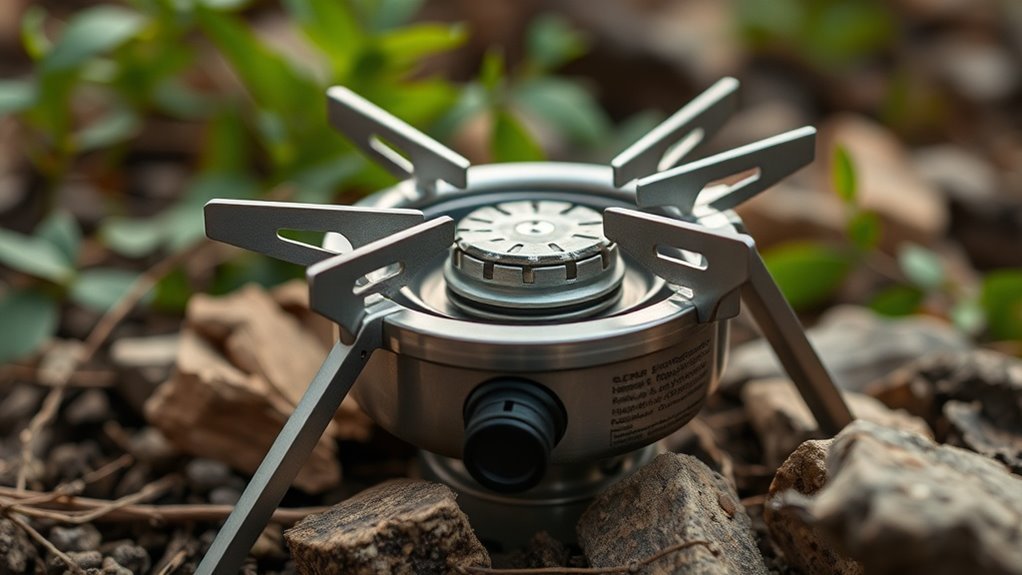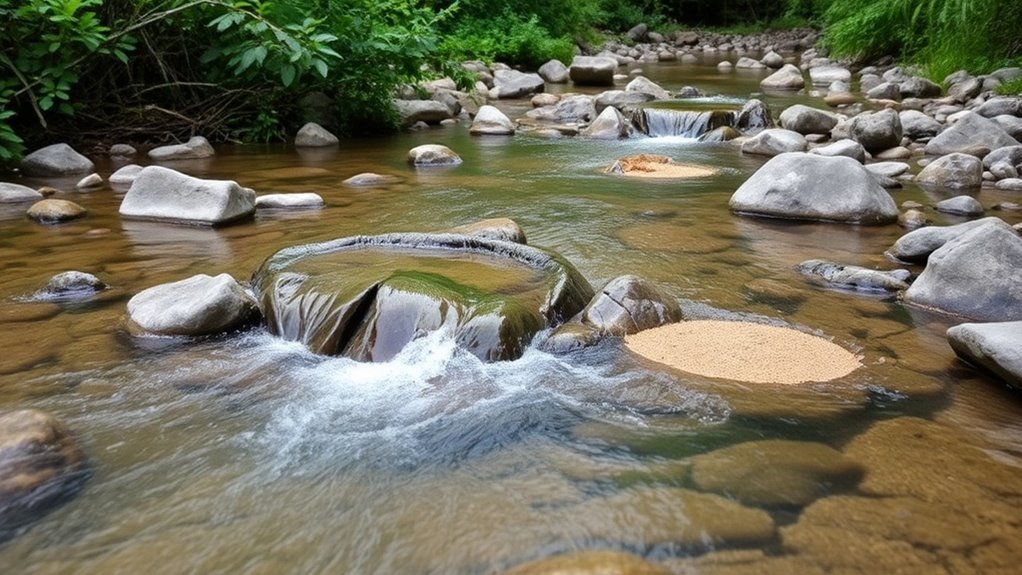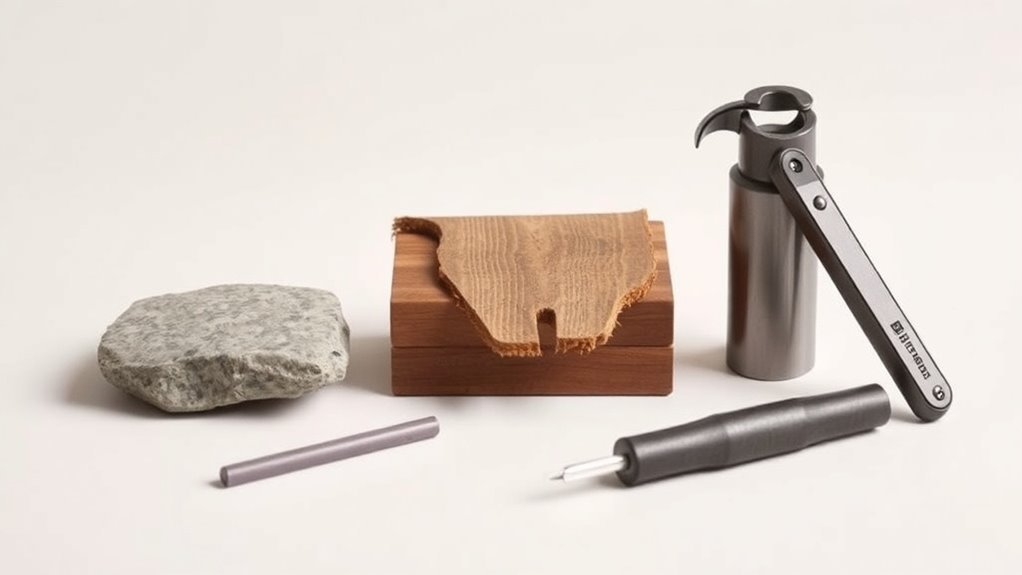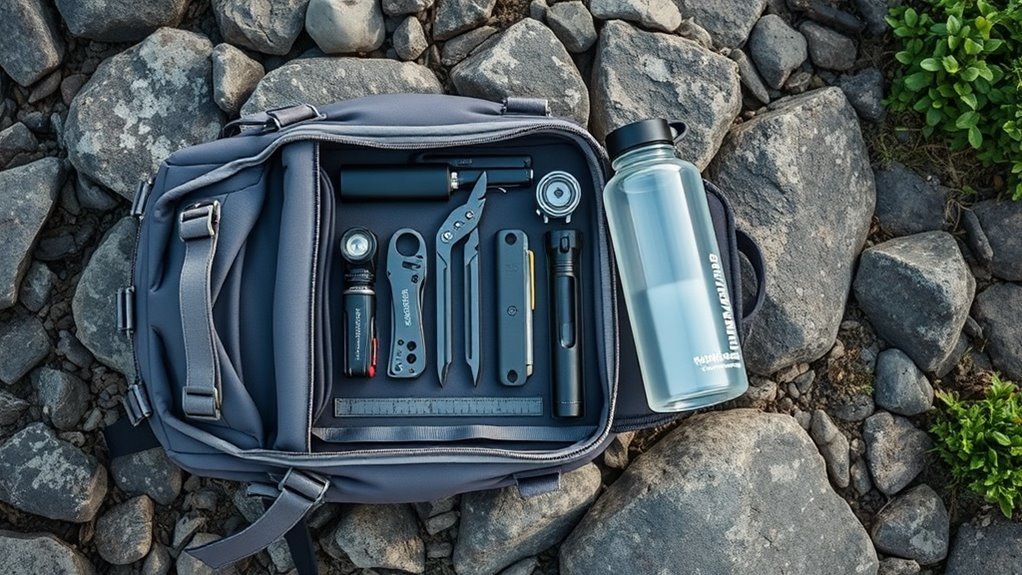How to Use Rope and Cordage Tools Outdoors
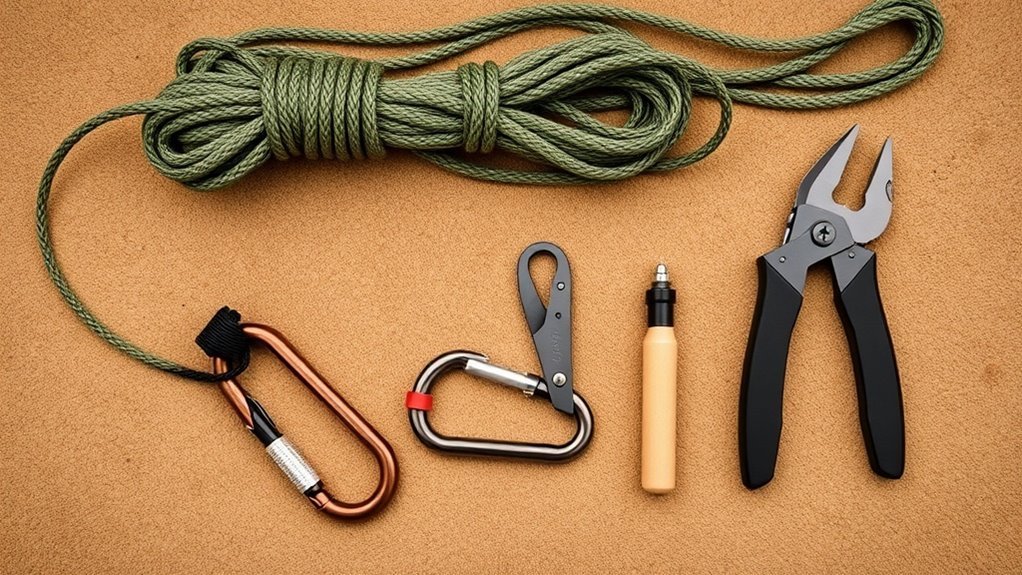
Using rope and cordage tools outdoors is essential for various tasks. You can secure gear, create shelters, and navigate tricky areas with confidence. Know your rope types—nylon, polypropylene, and polyester—and how thickness affects strength. Master essential knots like the square knot and bowline for safety. Regularly maintain your ropes and practice safe techniques. By familiarizing yourself with these basics, you’ll enhance your outdoor experience. Keep exploring to uncover innovative uses and guarantee a successful adventure.
Key Takeaways
- Choose the right type of rope for your activity, considering material, thickness, and length for optimal performance and safety.
- Master essential knots like the square knot, bowline, and taut-line hitch for securing items and creating adjustable tension in your setup.
- Use lashing techniques such as square and diagonal lashing to build sturdy structures or shelters with poles and ropes.
- Clean and properly store your ropes after use to extend their lifespan and maintain performance during outdoor activities.
- Always prioritize safety by wearing protective gear and using harnesses during climbing or rappelling activities for added security.
Understanding Different Types of Rope and Cordage
When it comes to outdoor activities, knowing the right type of rope or cordage can make all the difference in your adventure.
First, consider the material. Nylon is strong and stretchy, making it great for climbing or hauling gear, while polypropylene is lightweight and floats, ideal for water activities. If you’re looking for something sturdy yet flexible, go for polyester, which resists UV damage.
Next, think about the thickness and strength. A thicker rope will generally carry more weight, but too heavy can be cumbersome.
Remember, the right length is crucial, so always pack a little extra.
Finally, familiarize yourself with the specific uses of each type. It’ll guarantee you have the right tool for securing, towing, or building while you’re enjoying the great outdoors.
Essential Knot Tying Techniques
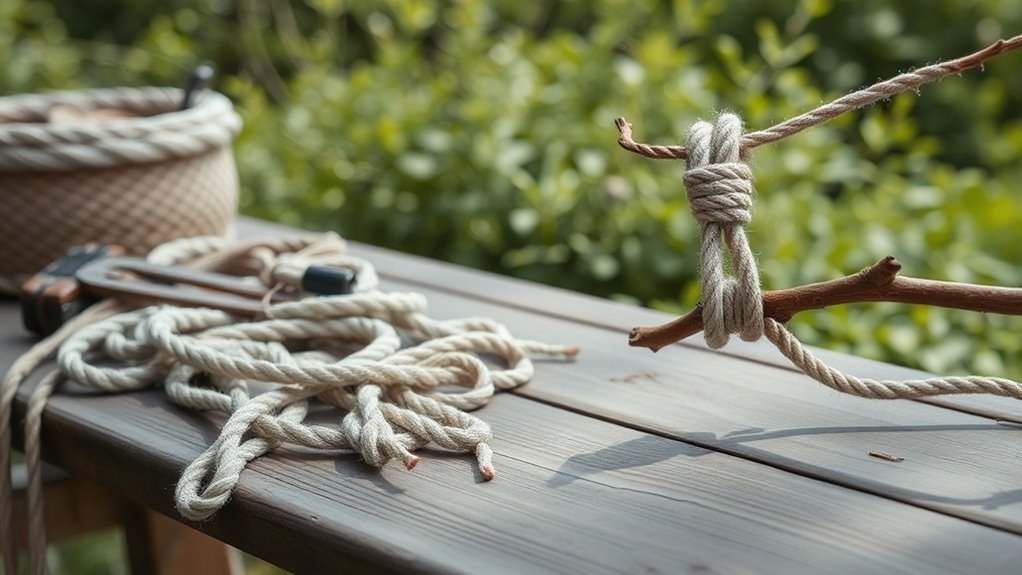
Mastering a few essential knot tying techniques can greatly enhance your outdoor experience. Start with the classic Square Knot; it’s perfect for joining two rope ends together.
Next, the Bowline creates a secure loop at the end of a rope, making it invaluable for rescue situations or mooring a boat. The Clove Hitch is another versatile knot, excellent for fastening a line to a post or tree.
Finally, the Taut-Line Hitch is perfect for adjustable tension, often used for securing tarps or tents. Practice these knots until you can tie them under various conditions. They’ll save you time, guarantee safety, and make your outdoor activities more enjoyable.
Lashing Techniques for Secure Shelters
Once you’ve got your knot-tying skills down, it’s time to apply them to lashing techniques for building secure shelters.
To start, the square lashing is ideal for joining two poles at a right angle. Wrap the cord around the poles, then cross it over to form an “X” before pulling tight.
Another effective method is the diagonal lashing, which provides extra stability for frame structures. Here, you’ll wrap the rope in a diagonal pattern, tightening as you go. Make certain you finish with a knot that won’t slip.
Finally, practice the clove hitch for quick attachment points. Remember, the strength of your shelter relies heavily on these lashing techniques, so take your time and get ’em right!
Best Practices for Rope Care and Maintenance
Although rope and cordage tools are essential for outdoor activities, their longevity relies heavily on proper care and maintenance.
Always store your ropes in a cool, dry place, free from direct sunlight to prevent UV damage. After use, clean them with mild soap and water, making sure you remove dirt and debris that can weaken fibers. Avoid exposing your ropes to harsh chemicals or extreme temperatures.
When not in use, keep them coiled neatly to prevent tangling and kinks. Inspect them regularly for frays, cuts, or signs of wear; if you spot any damage, replace them promptly.
Innovative Uses for Paracord in the Wild
There’s no denying that paracord is one of the most versatile tools you can carry in the wild. You can use it for everything from creating a shelter to securing gear.
Need a fishing line? Just unravel some strands and you’re set. Paracord also makes excellent tourniquets in emergencies or can be used to bind splints for injuries.
Need a quick fishing line? Just unravel some paracord strands, or use it as a tourniquet in emergencies.
If you need a makeshift dog leash, simply tie a sturdy knot. Got a backpack that’s falling apart? Fashion a replacement strap in no time!
You can even use paracord to create a snare for trapping small game. Its ability to stretch means it’s useful for a variety of tasks, making it truly an outdoor essential.
Safety Tips for Outdoor Rope Activities
When you’re working with ropes outdoors, it’s essential to master proper knot techniques to guarantee safety.
Always make certain you’re wearing protective gear to prevent injuries.
Let’s explore how these precautions can keep your outdoor activities both enjoyable and secure.
Proper Knot Techniques
Mastering proper knot techniques is essential for outdoor safety, as the right knots can prevent accidents and guarantee secure connections.
Start by learning a few fundamental knots, like the square knot for joining ropes and the bowline for creating a fixed loop.
When tying knots, confirm your working end is long enough for secure tying and practice regularly to build muscle memory. Always inspect your knots before use; a poorly tied knot can lead to failure in critical situations.
If you’re unsure about a knot’s security, don’t hesitate to untie and re-tie it.
Finally, remember to keep knots tidy—this helps you untie them more easily when you’re done. Your safety and success depend on mastering these essential techniques.
Wear Protective Gear
How can you guarantee your safety while using rope outdoors?
Wearing protective gear is essential. Start with a sturdy helmet to protect your head from any falling objects, especially when working at heights.
Gloves are also vital; they’ll safeguard your hands from abrasion and provide a better grip while handling ropes.
Don’t forget strong, non-slip footwear; this’ll help you maintain traction on various surfaces.
If you’re rappelling or climbing, invest in a well-fitted harness for added security.
Protective eyewear can shield your eyes from dust or debris.
Finally, dress in layers to adapt to changing weather conditions.
Choosing the Right Rope for Your Adventure
Choosing the right rope for your adventure can make all the difference, whether you’re hiking, camping, or engaging in outdoor sports.
First, consider the rope’s material: nylon is strong and durable, while polypropylene is lightweight and floats, ideal for water activities.
Next, think about the thickness; thicker ropes can handle more weight, but they also add bulk.
You’ll also want to assess the rope’s intended use—climbing requires dynamic rope for safety, while a static rope is better for rappelling.
Don’t forget to check the rope’s breaking strength, ensuring it fits your needs.
Finally, pay attention to the length; it should match the specific demands of your outing.
Making informed choices here will enhance your outdoor experience.
Questions
What Is the Best Length of Rope for Backpacking Trips?
For backpacking trips, you’ll want a rope around 50 to 100 feet. It offers versatility for various tasks like securing gear or setting up tarps. Just make sure it’s lightweight and easy to pack!
How Do I Untangle a Knotted Rope Quickly?
When you’re in a bind, it’s best to start by gently wiggling the knotted sections. Use your fingers to loosen any tight spots, and don’t rush; patience usually untangles even the trickiest knots.
Can I Use Paracord for Climbing Safety?
You shouldn’t rely on paracord for climbing safety. It’s not designed for that purpose and lacks the necessary strength. Always use climbing-specific ropes and equipment to guarantee your safety in high-altitude situations.
How Does Weather Affect Rope Performance Outdoors?
Weather can make or break your rope’s performance! Rain can weaken fibers, while intense sunlight can cause UV degradation. Always check conditions; your safety’s on the line, and a little weather goes a long way.
What Materials Are Best for Eco-Friendly Rope Choices?
For eco-friendly rope choices, you should consider materials like hemp, jute, and recycled polyester. These options biodegrade more easily and often come from sustainable sources, making them better for the environment than traditional synthetic ropes.
Conclusion
To sum up, mastering rope and cordage tools can elevate your outdoor experiences considerably. Did you know that 90% of outdoor enthusiasts find reliable rope skills essential for safety and comfort? By understanding different types of rope, perfecting knot-tying techniques, and knowing how to care for your gear, you’ll be well-equipped for whatever adventure awaits. So, get out there, practice your skills, and embrace the versatility of rope in the wild!


